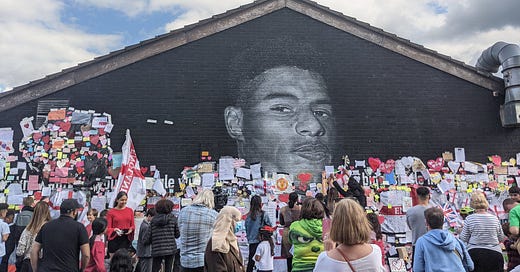Building a moral panic
A handful of social media posts resulted in a national conversation about an England that does not exist.
A few weeks on, the aftermath of England’s loss to Italy feels like a fever dream. The story for a week or so after the game was that the players who missed their penalties had faced a torrent of abuse. The symbolic event around which coverage focused was the mural of Marcus Rashford defaced with racist graffiti, with hundreds in turn taking the knee in front of it in protest, leaving hand-written messages and England flags to cover up the damage. The sheer volume of racist messages led Boris Johnson, UEFA, the FA, and others scrambled to release statements condemning the reaction from fans who represented the very worst of Britain.
Constant coverage of the appalling behaviour of England fans online forced the government onto the back foot. When Priti Patel condemned the abuse, Tyrone Mings’ Twitter account claimed that she had “stoke(d) the fire” by criticising taking the knee as “gesture politics”. MP Steve Baker claimed that it could be “a decisive moment” for the Conservative party. Eventually Boris Johnson announced that new legislation would give the government the power to fine social media companies up to 10% of their global revenue if they did not “get hate and racism off their platforms”; one of a number of “practical steps” to stop the “racist outpourings that we saw on Sunday night”.
And, slowly, attention moved on.
It was left for the days after for the truth to quietly slip out. The ‘racist’ graffiti on the Rashford mural turned out not to be racist at all; something cynics had started suspecting when no-one reporting on it would detail what it actually said. The torrent of abuse turned out to be a trickle, and much of it from overseas. The PFA found 2,000 abusive tweets sent to the players. Even if the true figure were 10 times higher, it would still be tiny relative to the sheer volume of output1. Of 105 Instagram accounts identified sending abuse, 59 were from outside the UK and just 5 within, fitting with what we already knew about the nature of social media — around 70% of online abuse directed at Premier League players comes from outside Britain.
Part of the problem is that social media involves a fundamental asymmetry of large numbers. When millions of tweets are sent, a thousand instances of racist abuse is a very small part of the whole. It is also an awfully large number to receive. We see the abusive tweets because they are condemned; very few people see the tens of thousands of anodyne messages below them.
Another, larger part is the dynamics of culture wars: there will always be someone, somewhere, who can be held up as an example of the problem to be addressed, and there is a strong incentive to find them to make your point. We are used to the trope of the time-pressured journalist finding a few tweets to construct a clickbait article around; we are less used to the fact that society can now construct political narratives through the same process. The result is that a handful of social media posts have resulted in a national conversation about a spectacle of an England that does not exist.
The England that we actually live in is a remarkably tolerant country. After a year of tense racial discourse, when three black players missed in a penalty shootout watched by over 31 million people, the overwhelming response was sympathy and support. Companies put up messages for ‘our three lions’. Their colleagues ran to comfort them. The Prime Minister spoke out to support them. People mass flagged and turned up in their hundreds to express sympathy. That a handful of racist comments were made and uniformly condemned among this speaks less to a great sickness at the core of our national spirit than a desire to see one.
The England we are discussing is a simulacrum built through trawling social media, an image of a country that has never existed, a virtual Britain that only barely touches our home as it is. When people ask why we are allowing such a small number of idiots to set the agenda in this fashion, they miss the point that the racists are not the ones in charge here; we are, and we are choosing to do this to ourselves.
Everyone involved knows perfectly well that we will never reach a state where abuse never happens. Instead, a dwindling number of cases are used as justification for ever more intervention, more proof that Britain is fundamentally racist, more ammunition for the next political argument. The discourse is policy-based evidence making taken to its logical conclusion. The social reality we live in is one of consensus. This can be seen clearly in the various appeals to mythologised pasts in justifying social changes today, whether “returning” to a vision of traditional living that was never quite as sold, or the claims that Britain has always been a diverse nation of immigrants because some sailors from Spain served on our ships.
A core set of facts can be used to construct entirely different visions of a country, supporting very different conclusions. What happened does not matter nearly so much as what people believe did.
Image courtesy of Dunk on Flickr, used under a Creative Commons licence
England’s loss to Iceland in 2016 was watched by 15.2 million people in the UK; 2.1 million tweets were sent about it. The Euro final was watched by 31 million people in Britain alone, more viewers than anything has attracted since 1997, and by an audience across the world. It would be exceptionally bold to assume that the denominator here is not many times larger, and far less weighted towards the UK.


